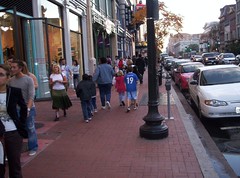MCI Arena as a way to re-engage suburbanites
 People on 7th Street NW, Saturday 11/5/2005.
People on 7th Street NW, Saturday 11/5/2005.I am not big on the statements that "MCI Arena saved the city and revitalized the East End."
To me, the primary reason that 7th Street NW is successful is that it is the longest stretch of extant historic buildings downtown, and at the street level, the the pedestrian-oriented rhythm of storefronts every 40 feet or so has been retained.
On the other hand, at the Historical Studies conference I was pleased to see the great architectural historian Nancy Schwartz, who lamentably lives in the suburbs.. It was great to catch up (a little) with her. She was the principal investigator on the "Capitol Hill North/Near Northeast Cultural and Social History Study," that I managed a few years ago. (In retrospect, I think I made a mistake in moving from that project to H Street Main Street. The number of historically-eligible buildings threatened by demolition continues to grow, and a number of buildings have been destroyed. I don't know if I'll ever get back to it.)
She disagreed pretty strongly with my characterization, stating that once MCI Arena was built, people who hadn't visited the city in 20 years started going back. And that Metro stations in Montgomery County have nearly-full parking lots at night and on weekends when there are popular events scheduled at the Arena.
Something to think about. I hate to say that the same thing happened with baseball and the Washington Nationals. Many of the game-goers were suburbanites, who came to the city and spent some money either before or after the game, in local establishments such as the nearby restaurants on 8th Street SE. (However, I still don't think that means spend $535 million on a stadium...)



0 Comments:
Post a Comment
<< Home